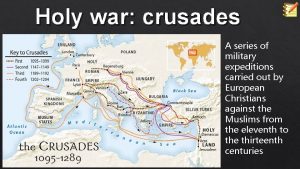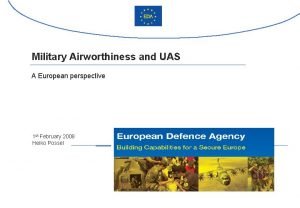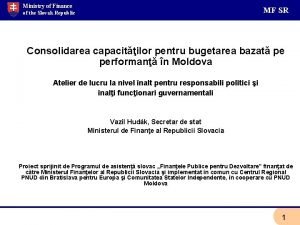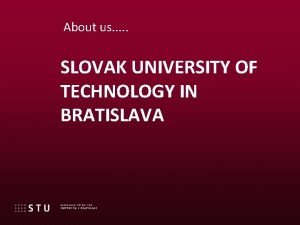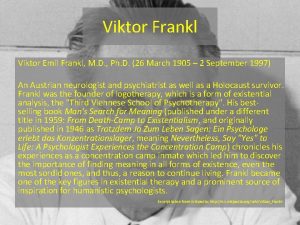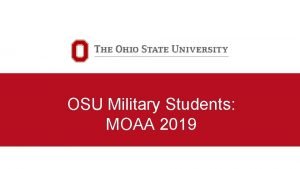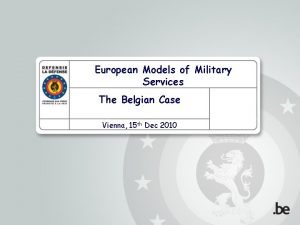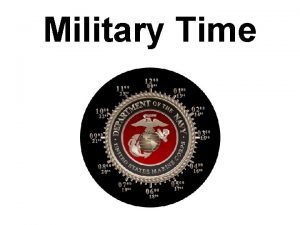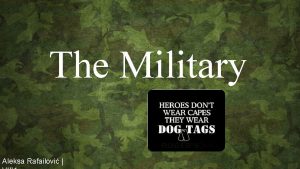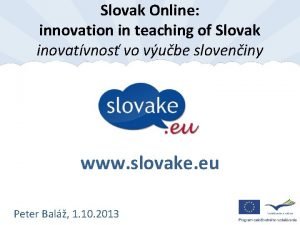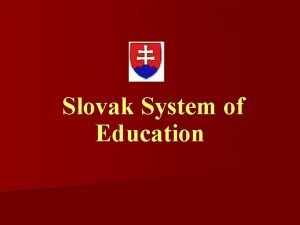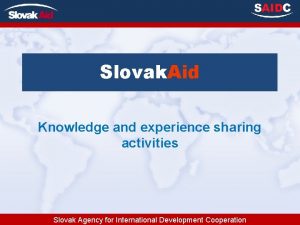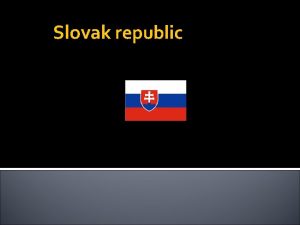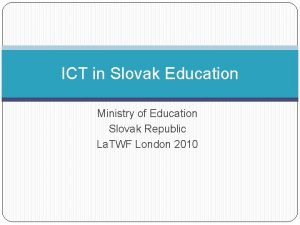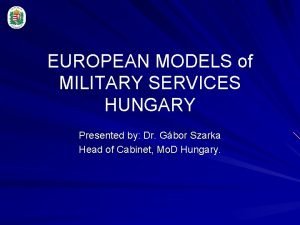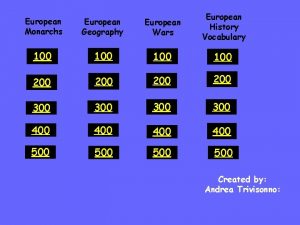European Models of Military Services Slovak Case Study



















- Slides: 19

European Models of Military Services Slovak Case Study Col. Boris SLODICKA Vienna, 15 th December 2010 * 1

„European Models of Military Services “ Slovak case study Current System of Military Service * • • Fully voluntary Military Service since 2005 Type of contract – Enlisted – short term contract (3 to 5 years/max up to 10 years) – NCO Corps – long term contract – Warrant Officers – long term contract – Commissioned Officers – long term contract – Active Reserve – legal basis but not implemented yet • Long term contract – Could be life long depends on promotion – Basic limits of service • Max. physical age up to 55 years • Length of service up to 32 years • Length of service in rank (depend on rank) 2

Career and Rank Development ENLISTED AND NCO SC SC V O -6 V O -5 V CC O -4 V V WO BASIC COURSE SC CC V Higher Officers Course O -2 V V E -4 O -1 V E -3 O– 1 ENTRY SPECIALTY OFFICERS COURSE CAREER COURSE V (FOR LIEUTENANTS) E -2 Combat – 1 SPECIALIZED TRAINING E Civilians after university Cadets BASIC TRAINING E– 2 O– 1 Bac. (Mg. ) study at Military school E– 1 TEMPORARY STATE SERVICE PREPARATORY STATE SERVICE APPLICANT Basic Command Staff Course O -3 V E -5 TC Higher Command Staff Course V WO - 1 E -6 TC V WO - 2 E -7 TC National Security Course SC E -8 TC O– 7 ažO-10 WO - 3 E -9 TC OFFICERS WARRANT OFFICERS LEGEND: V Competitive selection TC Training course CC Career course SC Specialty course Main line of development Reserve soldier Registered recruited SELECTED Adjacent line of development SLOVAK CITIZENS * 11/27/2020 3 3

OF - 10 Officer Military Career 1 2 3 4 OF - 9 Explanations: on 30. 6. -Annual Leave 21 days -Entry Specialty Officer Course, - 2 -18 m onth starting on 1. 8. - Service Entry on 1. 1. = Selection for promotion and training = Promotion P M = Maximum 2 3 P 1 OF - 7 3 2 4 5 P 1 2 3 4 5 M 6 OF -6 P V 1 OF -5 – Time in Service KK = Career Course = Retention Program U 2 3 4 U 5 7 6 1 OF -4 2 3 4 5 6 7 8 9 9 9 U 1 2 3 4 5 6 7 7 8 9 9 10 M P P M P KK V U 1 6 9 M V OF -3 8 OKF U OF - 2 M 6 V Time in Service = Separation M 4 V F 1 = TIS Z 1 OF - 8 A = Graduation V P 8 9 10 11 12 V M P OKF U 1 OF - 1 2 3 4 5 6 7 8 9 V KK 1 A 1 2 3 4 5 U 6 7 8 9 10 V 2 3 4 5 6 7 8 9 10 M P P 11 12 13 14 15 16 17 18 19 20 TIME 23 24 25 26 27 28 29 30 31 32 IN 33 34 35 36 37 38 39 40 41 42 43 PHYSICAL * 11/27/2020 21 22 23 24 25 26 27 28 29 30 31 32 33 34 35 36 37 38 39 40 SERVICE 44 45 46 47 48 49 50 51 52 53 54 55 56 57 58 59 60 61 62 AGE 4 4 4

Current System of Military Service vs. Military Tasks • Basic principle one set of forces for all task – Contribution to operation – NATINADs – NATO NRF/EU BG – Disaster Relief • • * Homeland Security Territorial Defence Disaster Relief International Crisis Management 5

„European Models of Military Services “ Slovak case study Slovak AF Transformation Model 2010/2015/2020 To establish - an effective, professional but affordable Armed Forces organised, equipped and trained to comply with the Military (Defense) Strategy of SR, - a modernised Armed Forces to be interoperable with NATO military organisations, and supported by effective and efficient supporting activities. * 6

„European Models of Military Services “ Slovak case study * 1993 2009 Personnel 53037 14 800 Battle Tank 995 30 APC 1370 240 Artillery 1058 42 Aircraft 146 15 Helicopter 36 22 7

„European Models of Military Services “ Slovak case study 1999 Establishment of services HQs 1994 Transformation division to corps 2000 Transformation to 1. a 2. mech brig. , , artillery brig Homeland HQ and 4 mob. base Model 2020 Model 2015 * Concept of the Mo. D reform Until 2002 Model 2010 Concept of the reform of the Army of the SR until 2000 2001 -2006 Implementation of M 2010 8

„European Models of Military Services “ Slovak case study Objective of the AF Reform: • To establish a single, modern and effective military personnel management system • To reduce personnel strength and change its structure * 9

„European Models of Military Services “ Slovak case study 2000 2004 33 641 18 170 11 967 * 7 568 2009 16531 14 869 3600 3139 10

Model of Strengths Development Plan up to year 2006 : separation of 14 100 personnel, accession of 10 900 personnel * 11

AF SR Personnel Stabilization Release 2002 2004 2006 2008 Recruitment 2002 * 11/27/2020 2004 2006 2008 12 12

„European Models of Military Services “ Slovak case study Personnel Transformation – Rank Structure Generals 519 Colonels Lieutenants * Colonels 2001 86 LT Colonels 1480 Majors 18 Generals 1527 LT Colonels Captains 18 2009 220 425 Majors Captains 1712 Lieutenants 2009 894 1795 13

Political and Strategic Consideration leading to the Current System of Military Service Former conscript vs. Current Fully Voluntary • More Effective and Efficient use of public spending • Current security assessment does not require use of large armed forces based on mobilization • As a member of the NATO and EU we are consumer of security and in the same time we have to be provider (contribution to NATO/EU led operation) and conscript service do not allow their deployment • Current operations of the International Crisis Management required well prepared, equipped and motivated soldiers * 14

„European Models of Military Services “ Slovak case study Critical Elements of Implementation - * Reduce a legacy “top heavy structure” with excess senior military personnel Significantly change the roles of Officers from “specialists” technicians to “generalists” leaders Create a new kind of Warrant Officer Corps (broad based technicians) Build a NCO Corps to replace officer technicians Centralize personnel management under the Chief of the General Staff Ensure “Civilian Oversight” Build a legal framework that does both 15

Social and Economic Side-effects * • Military service is receding from the minds of society • Military service is gradually being perceived as one of many professions • Budget cuts 16

Budget consequences of the change of military service * Short term Long term • • Severance pay Transition assistance Marketing cost Recruitment bonuses Training cost Early retirement cost Service outsourcing cost High personnel turnover 17

Main Lesson Learned with regard to implementation process • • * What should be considered? – Political support – Personnel reform cant be isolated. Should be accompanied by others changes – structure, doctrines, SOPs – Meticulously tailored social compensations (amount, time) – Synchronization with other reforms What should be avoided? – Overshooting of social compensations – long term consequences – Dismissing quality personnel – Canceling vacant positions rather than whole units – Extensive civilianization – not to truncate the flow of military know-how Time lines – Detailed planning – 1 year – Fast execution – 2 years Recruitment Process – Recruitment system and personnel management managed by the same authority – Balanced recruitment goals – to avoid waves in personnel structure 18

Thank you for your attention * 19
 Military expeditions carried out by european christians
Military expeditions carried out by european christians European union military
European union military European military airworthiness requirements
European military airworthiness requirements Best case worst case average case
Best case worst case average case Project failure case study
Project failure case study Slovak trade inspection
Slovak trade inspection Slovak traditions easter
Slovak traditions easter Slovak wedding traditions
Slovak wedding traditions Slovak centre of scientific and technical information
Slovak centre of scientific and technical information Slovak finante
Slovak finante Polish beetle tongue twister
Polish beetle tongue twister School system in slovakia
School system in slovakia Slovakia christmas carp
Slovakia christmas carp Slovak university of technology in bratislava
Slovak university of technology in bratislava Emil slovak md
Emil slovak md Slovak
Slovak Slovak zion synod
Slovak zion synod Slovak opal
Slovak opal Osu military
Osu military Semi modals examples
Semi modals examples
